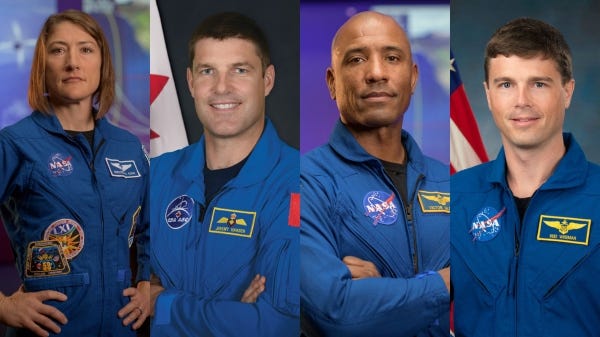
Though we all have differences, there’s one commonality that has prevailed for all of humanity: we are all floating on a rock, flying through outer space at over a million miles an hour.
Thanks to the rapid advancement of technology in the past century, we can observe much more of the universe than we ever thought possible.
The scale and sheer size of the universe make it impossible to truly learn everything, but it doesn’t mean we shouldn’t try.
Here's what's happening in space this week.
NASA and CSA (Canadian Space Agency) have revealed the four astronauts who will journey to the Moon in the historic Artemis II mission, the first crewed mission to the Moon in over 50 years.
The announcement was made early Monday morning at the NASA Johnson Space Center's Ellington Field in Houston, Texas.
MEET THE ASTRONAUTS
Christina H. Koch - ARTEMIS II MISSION SPECIALIST
Prior to becoming an astronaut, Christina Koch worked as an Electrical Engineer at NASA’s Goddard Space Flight Center where she contributed to scientific instruments on several NASA space science missions. She is the only engineer on the crew of Artemis II. She also worked as a Research Associate in the United States Antarctic Program and as an Electrical Engineer at the Johns Hopkins University Applied Physics Laboratory.
Koch was selected as a member of the 21st NASA astronaut class in 2013 and completed Astronaut Candidate Training which included training in International Space Station systems, spacewalking, and Russian language. In 2019, she launched on her first spaceflight to the International Space Station where she conducted six spacewalks, including the first three all-women spacewalks, and contributed to hundreds of experiments in various fields. She has spent a total of 328 days in space.
Jeremy Hansen - ARTEMIS II MISSION SPECIALIST
Colonel Jeremy Hansen will be the first Canadian to orbit the Moon. His journey into aviation began at the age of 12 when he joined the Royal Canadian Air Cadet Squadron. He completed his bachelor's degree in honours space science from the Royal Military College of Canada in Kingston, Ontario, in 1999.
He served as a CF-18 fighter pilot and was selected by the Canadian Space Agency to become an astronaut in 2009. Hansen has received several special honors throughout his career, including the Queen Elizabeth II Diamond Jubilee Medal in 2012 and the Gold Medal of the Royal Canadian Geographical Society in 2014.
Victor Glover - ARTEMIS II PILOT
Victor Glover earned his wings of gold in 2001 and completed his F/A‐18C syllabus with the Blue Blasters in 2003. He then attended the Air Force Test Pilot School, served as a test pilot with the Dust Devils, and received a Master of Science degree in Systems Engineering. He is the only person in his family who attended college.
Glover deployed three times with the Dambusters before being selected as an astronaut candidate in 2013. He completed Astronaut Candidate Training in 2015 and served Flight Engineer on the International Space Station for Expedition 64.
Reid Wiseman - ARTEMIS II COMMANDER
Reid Wiseman is an astronaut, engineer, and naval aviator. He served as Flight Engineer aboard the International Space Station for Expedition 41 from May through November of 2014. During the 165-day mission, Reid and his crewmates completed over 300 scientific experiments in areas such as human physiology, medicine, physical science, Earth science, and astrophysics.
They set a milestone for station science by completing a record 82 hours of research in a single week. Reid was commissioned through the Reserve Officers’ Training Corps (ROTC) and served as a Naval Aviator before joining NASA in 2009. Reid was selected in June 2009 as one of 9 members of the 20th NASA astronaut class. He most recently served as Chief of the Astronaut Office.
The announcement comes just five months after the historic launch of the Artemis I rocket, which ushered in a new era of lunar exploration.
The mission experienced a series of several delays, but ultimately was completed in December after a 25 day trek around the Moon.
Artemis II will be even more historic, however, as it is the first manned mission to utilize NASA's new Orion spacecraft as well as the Space Launch System, the agency's largest and most powerful rocket ever.
The Artemis II mission will send the crew on a test flight around the Moon, but will not land on the lunar surface.
The four astronauts selected will be the first crew NASA has sent to the Moon since the Apollo 17 mission in 1972, over 50 years ago.
The mission is the next step in bringing humans to the lunar surface, and ultimately to Mars.
LISTEN on the Audacy App
Tell your Smart Speaker to "PLAY 1080 KRLD"
Sign Up and Follow NewsRadio 1080 KRLD
Facebook | Twitter | Instagram

